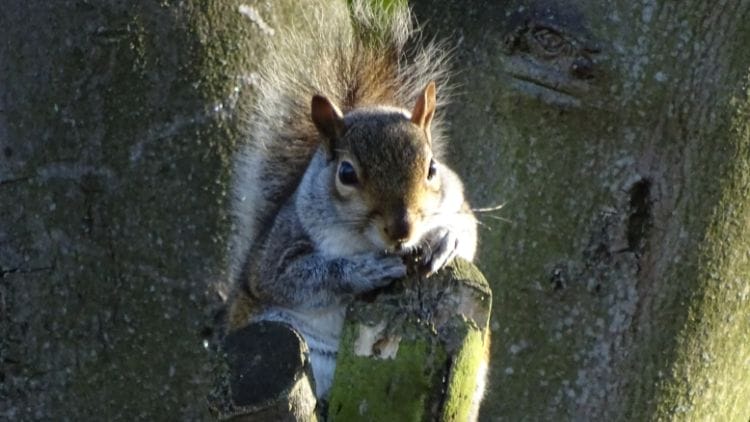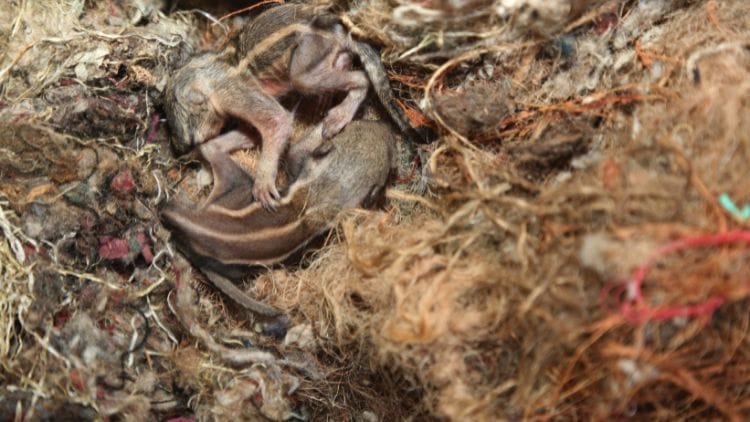Squirrels primarily sleep in nests or dens, which provide safety from predators and harsh weather conditions. Depending on the species, these sleeping spots can be found in the branches of trees, within hollow parts of trees, or underground in burrows.
Squirrels are among the most versatile and adaptable critters in the animal kingdom, with a wide array of sleeping habits that reflect their resilience and ingenuity. These small but fascinating creatures have developed various strategies for finding a safe and comfortable place to sleep, depending on the species, the environment, and the time of year. This comprehensive exploration delves into the world of squirrels, offering insights into their sleep habits, the types of shelters they use, and how human activity impacts their choices of sleeping spots.
Here are some related animal articles that help you to learn something new:
- Top 10 Animals with Good Memory.
- Top 10 Long Tail Animals of the World.
- Three Letter Animals | List of 22 Names With Facts & Image.
Key Takeaways
- Squirrels sleep in nests, tree cavities, underground burrows, and occasionally in human structures.
- Sleep patterns vary by species and season, with some squirrels hibernating through winter.
- Squirrel nests are ingeniously constructed for warmth, safety, and raising young.
- Human activity impacts squirrel sleeping spots, highlighting the need for habitat conservation.
- Respect and understanding of squirrel habits can enhance coexistence between humans and wildlife.
Introduction to Squirrel Sleep Habits

Squirrels are predominantly diurnal, engaging in their bustling activities during the day and retreating to their nests for rest at night. However, their sleep patterns and locations vary widely, influenced by the need for security and comfort. Contrary to popular belief, squirrels don’t usually sleep on their backs. Instead, they curl up in a way that conserves body heat and offers protection. It’s not uncommon for these animals to sleep for about 12 to 20 hours a day, a duration that helps them conserve energy for foraging, escaping predators, and other daily activities.
Where Squirrels Go to Sleep
The choice of sleeping spot is crucial for a squirrel’s survival. They primarily seek out locations that offer protection from predators and harsh weather conditions:
- Tree Squirrels: These squirrels, including species like the gray and fox squirrel, typically find solace in nests called “dreys,” which are meticulously constructed on the side of a tree or within the branches. These dreys consist of leaves and twigs arranged in a way that provides insulation and protection. Some tree squirrels may also sleep in tree cavities, which offer additional shelter from the elements.
- Ground Squirrels: In contrast, ground squirrels, such as the red squirrel, hibernate in underground burrows during the winter months. These burrows are not just simple holes in the ground but complex networks with multiple chambers and entrances for rest, storage, and hibernation. During warmer months, ground squirrels may also sleep in these burrows to escape the heat through a process known as estivation, the opposite of hibernation.
- Flying Squirrels: These nocturnal creatures reverse the typical squirrel sleep pattern, resting during the day in high tree hollows or specially designed nest boxes. Their nocturnal nature means they’re active at night, foraging for food and engaging in other activities.
Squirrels in Human Spaces

It’s not uncommon for squirrels to set up shop in human-made structures, such as attics, sheds, or even between walls. While these spaces can offer squirrels shelter and protection, their presence is often less welcomed by homeowners due to the potential damage they can cause, such as gnawing on wires and building materials. Relocating squirrels that have made their way into human homes should be done humanely and in accordance with local wildlife laws, often requiring the expertise of a professional pest control service.
Fascinating Facts About Squirrel Sleep Habits
- -Squirrels may share nests for warmth during cold weather.
- Some squirrels, like the flying squirrel, are nocturnal and have reversed sleep patterns.
- Squirrels rarely sleep on their backs, preferring curled positions for warmth and security.
Debunking Myths About Squirrel Sleep Patterns

There are many myths about squirrels, such as the belief that they hibernate like bears or sleep hanging by their tails. These myths are largely unfounded and do not reflect the true nature of squirrel behaviour.
The Construction and Purpose of Squirrel Nests
Squirrel nests, or dreys, serve multiple purposes: they provide shelter from the weather, safety from predators, and a cosy place for raising young. The outer layers of these nests are typically made from twigs and tree bark, while the inner layers are lined with softer materials like moss, feathers, and fur, all arranged to create insulation and protection.
Squirrel Sleep Patterns vs. Other Wildlife
Compared to other wildlife, squirrels have unique sleep patterns that reflect their adaptable nature and survival strategies. While some animals migrate or hibernate to escape winter, squirrels prepare and endure, showcasing their resilience.
Squirrel sleep patterns and their adjustments to seasonal changes are prime examples of these animals’ adaptability and survival strategies. Squirrels, diverse in species and habitats, exhibit a range of behaviors that allow them to thrive throughout the changing seasons. These patterns are not only fascinating from a biological standpoint but also highlight the intricate balance between wildlife and their natural environment.
Adaptation to Seasonal Changes
Environmental factors, such as temperature, availability of food, and daylight hours, play significant roles in determining squirrel sleep patterns and behaviors across seasons. Squirrels are sensitive to these changes and adjust their activities and sleep accordingly to maintain their energy levels and ensure their survival. The flexibility of their sleep patterns in response to seasonal variations showcases their remarkable ability to adapt to their ever-changing environments.
Spring and Summer
During the warm summer months, squirrels are highly active, taking advantage of the abundance of food. This is a critical time for them to forage for food, such as nuts, seeds, and tree bark, which they often cache for later use. Despite the longer daylight hours extending their active periods, squirrels still maintain their diurnal pattern, resting at night. However, they may sleep less during these months due to the increased need to gather food and engage in social behaviors.
Fall
As the months transition into fall, squirrels become even more industrious, if possible. This is the peak time for them to collect and store food in preparation for the winter. Their sleep patterns during this time are heavily influenced by the need to secure enough resources to last through the colder months. Squirrels may adjust their sleeping habits to maximize their foraging time, often seen bustling about from dawn till dusk.
Winter
Winter presents a significant shift for squirrels, especially for those species that experience harsh cold conditions. While tree squirrels do not hibernate, they exhibit a behaviour known as torpor, a state of decreased physiological activity that allows them to conserve energy. During this time, squirrels rely heavily on the food caches they have amassed, venturing out less frequently and for shorter periods. Their sleep cycles during winter can extend longer than in other seasons, as conserving warmth and energy becomes paramount. Ground squirrels, on the other hand, may enter true hibernation, retreating to their burrows and significantly reducing their metabolic rate to survive the winter.
Special Cases: Hibernation and Estivation
Certain species of ground squirrels exhibit unique adaptations to extreme seasonal changes through hibernation and estivation. Hibernation is a deep sleep that helps them conserve energy during the cold winter months when food is scarce. This involves lowering their body temperature, slowing their metabolism, and entering a state of dormancy that can last for several months. Estivation, its warm-weather counterpart, allows squirrels to escape the intense heat and drought conditions of summer. During estivation, squirrels retreat to their burrows, reducing their activity levels and metabolic rate to conserve water and survive until conditions improve.
The Challenge of Predators
Despite their well-constructed nests and burrows, squirrels are always at risk from predators. Tree nests reduce the risk from ground predators, but squirrels must remain vigilant for threats from the air, such as birds of prey. The complexity of ground squirrel burrows, with their multiple entrances and chambers, can help evade snakes and other burrowing predators. Squirrels employ various strategies to stay safe while sleeping, including choosing well-concealed spots and remaining silent to avoid drawing attention to their presence.
Squirrels and Human Interaction
Human activity, such as deforestation and urbanization, has a profound effect on squirrel habitats, forcing these adaptable creatures into less ideal sleeping spots. However, squirrels have shown remarkable resilience, often finding new ways to coexist in changing environments. This adaptability is a testament to their survival skills but also highlights the need for humans to respect and protect natural habitats to ensure the continued coexistence of wildlife in our shared spaces.
Conclusion
Squirrels’ sleeping habits are a fascinating aspect of their behaviour, reflecting their adaptability, ingenuity, and the challenges they face in their natural and urban environments. From the intricately constructed dreys high in the branches of a tree to the complex underground burrows, squirrels make remarkable efforts to find a safe place to sleep. As one of the most common and visible wildlife species, squirrels remind us of the importance of respecting and protecting their natural habitats. By understanding and appreciating the complexity of their lives, including their unique sleeping habits, we can foster a more harmonious relationship with the wildlife that surrounds us.


You May Also Read